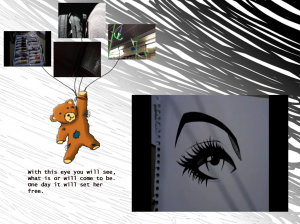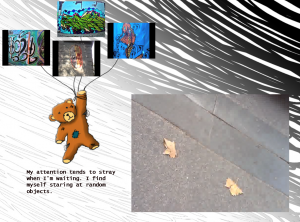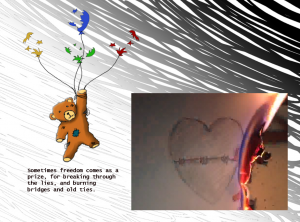Korsakow Film Link: http://vogmae.net.au/classworks/media/2012/kfilms/deardiary/
The Korskow film I have chosen as the subject for this essay is Dear Diary, which was made by Kai Ebato, Sherilyn Wong and Kyesha Keleher. When I first watched it, I noticed that it was a lot more colourful than most Korsakow films I had seen recently, as the makers have chosen to use a hand-drawn background in colour. The drawing depicts a teddy bear, which looks quite damaged and old, floating away on four ‘balloons’. However, in place of the balloons are the previews for the other videos the makers have prepared. When you place your cursor over the preview, the video will play within it. The main SNU video is displayed at the bottom right corner of the webpage, and takes up a large amount of space, quickly grabbing your attention. The makers have also placed different text, from just a single word to a poem, below the position of the teddy bear for each video of the film. Probably the most noticeable aspect of Dear Diary is that the film is completely narrated. The audio track features a 16 year old girl narrating what she is writing into her diary, hence the title. There are many ‘entries’ in the diary, and each one tells us more about the girl.
Ebato, Wong and Keleher rely on patterns to allow the connections of each video they have made to tie in with the story of Dear Diary. Very often, the previews (or balloons) are all related in the content of the video. For example, the makers often choose to group the videos of street art and religion together, as they’re all related. Other categories include animals and suburban life – the makers group these all together in the previews. All the videos also have more than one life, as I have played them several times. However, there is one video that only has one life, and it’s actually the closing SNU of the Dear Diary. The video depicts a drawing of a broken heart that has been sewn together. The drawing (which is on a piece of paper) is slowly burning away. The video shows the entire burning process, and once the drawing has been completely burnt away, it finally ends. I’ve also noticed that the only way to get to this ending clip is from a video of Jesus. The video shows a painting of Jesus, and the featured text is “really”.
Dear Diary opens the film with a video of drawing on paper. It’s a detailed drawing of an eye. The audio kicks in with the girl’s first diary entry. This opening audio track is more or less a quick description of the girl. From the narration, we know her name (Leandra, though I’m not sure if I’ve spelt it correctly), her opinions on certain things such as the colour pink, and her parents. She also mentions in the narration that she will name her diary after her brother, Luke. All the videos in the film are related to the narration at some point. In the background of the track, we can hear cars and trains rushing past, signifying a suburban lifestyle. The shots of streets and public transport also reinforce the suburban aspect of the film as well as the character of the girl.
As Dear Diary progresses, we start to learn who Luke is, and that a lot of the videos we have seen relate to him. Luke is the girl’s brother who had run away from home. He was a street artist, hence the many videos of graffiti and abstract drawings on paper. Luke’s parents, who were very strict and religious, drove him to leave home. I believe that Luke is what the makers want to focus our attention on. For example, I find a lot of the videos that are related to him are all grouped together as I mentioned earlier. This applies to all the sketches and street art videos. However, other clips that can be associated with Luke are scattered throughout the film, including shots of parcels and mailboxes, which links to Luke’s parcels that the girl mentions in the narration.
It’s a sad tale that Ebato, Wong and Keleher are telling with Dear Diary, as it’s very much a story about how a girl lost her brother, but I also think it explores the themes of religion and conformity. There’s a section in the narration when the girl mentions that her mother called Luke a Satanist because of his interests in art. I think it’s interesting that a video about religion leads to the closing SNU of the film. I think these two themes go hand in hand, as the girl is often always under pressure of religion and having to be forced to do abide by the ‘correct’ ways set by her parents. Although there is a closing video clip, the audio takes a while to end, though I believe that’s where the story really is. The last entry is an ending to the story, where the girl graduates from high school. She says that her parents have secured her a spot in the University of Melbourne, but she has actually enrolled in an animation course at New York University and will be living with Luke, following in his footsteps.
Thus, Dear Diary, to me, is a story about growing up and being who you are. The idea of moving on from being a child to an adult is supported by the interface, with the hand-drawn teddy bear and the placement of the previews as balloons, to the way the pattern works, grouping all the things holding her back together. This is a story that all of us can probably relate to, as we might have gone through the same thing during high school – being forced to do a certain course, getting good grades, going to church. I believe Ebato, Wong and Keleher are trying to convey a message of being yourself, and I think they’ve achieved it remarkably well.



